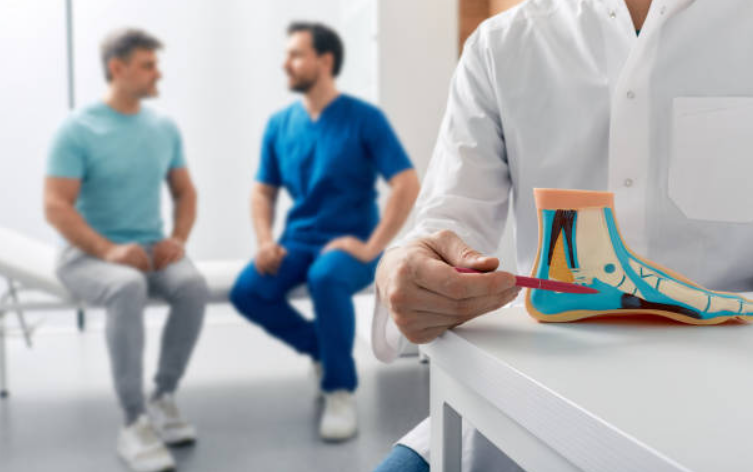
Podiatric medicine continues to evolve with advancements in analysis and treatment techniques. From custom orthotics to innovative therapies like dry needling and laser therapy, podiatrists are equipped with diverse tools to address foot and ankle conditions effectively.
Orthotics provide vital support, aiding in pain relief and rehabilitation post-trauma or surgery. Dry needling offers swift relief by targeting muscle tension, while laser therapy accelerates healing processes. Physiotherapy remains a cornerstone, addressing various health issues from chronic pain to pregnancy-related discomfort.
This article explores these innovations, highlighting their transformative impact on podiatric care.
Orthotics
Orthotics are prescription shoe inserts that treat many foot conditions and help relieve heel, foot, and ankle pain. They are often used as an adjunct to other treatments including physiotherapy, exercises, and in some cases medication. Orthotics can help improve balance and posture in patients suffering from foot and ankle injuries and are an essential component of rehabilitation after trauma or surgery to the lower extremities.
Having the right foot support is vital to maintaining mobility and preventing painful overuse injuries such as shin splints and plantar fasciitis. A podiatrist can prescribe a custom orthotic for your specific needs to address your foot problem. These can vary in shape, size, material, and cost depending on where you get them from.
MJB Balwyn North podiatrists will evaluate your foot and how you move (known as gait analysis) to determine whether orthotics are needed. They will take into account medical problems, your lifestyle and activities, and your foot type. They will also assess your weight-bearing foot position, joint axis positioning, range of motion, muscle strength, and foot function.
Dry Needling
When muscles are overused or strained, they develop knotted areas of muscle called myofascial trigger points. These areas are painful and limit movement. Dry needling uses needles to break up these tight muscle knots decrease pain and improve mobility. Many patients experience improvement in their pain and mobility almost immediately after their first session of dry needling. Others may require more than one session.
The goal of dry needling is to disrupt the status quo in your muscles and bring new blood into the area, stimulating the release of your body’s natural painkillers. The prick from the needle can also fire off nerve fibers, which help your brain calm down the area.
A trained practitioner will insert a needle through the skin directly into your muscle’s trigger point. They might move the needle around a bit in an attempt to get what’s known as a local twitch response, which is a quick spasm of the muscle. This reaction is a good sign that the treatment is working.
Studies have found that if you get your trigger points treated regularly, it can reduce the symptoms of several conditions. These include neck and back pain, jaw problems, such as temporomandibular joint (TMJ) disorder, and carpal tunnel syndrome. The treatments can also ease chronic headaches, such as tension or migraine headaches.
Laser Therapy
Laser therapy is a non-invasive, painless treatment that helps speed up healing and improve foot and ankle health. Also known as photobiomodulation, laser therapy uses specific wavelengths of light to penetrate deep into tissues and stimulate cellular processes.
It is very safe, and there are no significant side effects associated with this procedure. You may experience a slight tingling sensation in the area of the treatment, which usually subsides within four to six hours. A cooling pad or moist cloth can be used to reduce this feeling if necessary.
In addition, laser therapy has been shown to increase the levels of a substance called superoxide dismutase, which helps eliminate inflammatory chemicals and speeds up the body’s natural healing process. Because of this, it can be an effective treatment for conditions such as plantar warts.
It is important to discuss your motivations, expectations, and potential risks with a podiatrist before you undergo any procedure. You will also need to let your doctor know if you take any medications that can affect blood clotting as well as whether you are pregnant or breastfeeding. It is also recommended that you arrange for someone to drive you home if you are having laser therapy under sedation. Depending on the type of treatment you receive, you might have to keep the treated area covered with a nonstick dressing or ointment until it heals.
Physiotherapy
Physiotherapy is a physical treatment that uses manual techniques such as massage, stretching, joint manipulation, and movement exercises. Physiotherapy is used to diagnose, treat, and manage health problems, injuries, and disabilities. It focuses on the musculoskeletal system and is a great option for treating a wide range of conditions like chronic pain, arthritis, fibromyalgia, and respiratory disorders.
Physiotherapy is very important during pregnancy and after childbirth, as it addresses musculoskeletal discomfort and enhances general physical well-being. It can also improve a person’s ability to participate in their everyday life and activities by increasing strength, balance, and mobility. It also helps with age-related symptoms by enhancing quality of life and managing pain effectively. This can be done through a combination of therapies including manual therapy, exercise, education, and advice.
For those interested in delving deeper into innovative podiatric care and exploring personalized treatment options, a visit to the Muscle Joint Bone Clinic is highly recommended. This comprehensive resource offers insights into advanced podiatric techniques and services, provided by their expert practitioners. By browsing their website, individuals can gain a better understanding of tailored orthotic solutions, along with other cutting-edge therapies like dry needling and laser therapy. With a focus on patient-centered care and holistic foot health, Muscle Joint Bone Clinic provides valuable information for optimizing foot function and overall well-being. Visit website here now.

Recent Comments